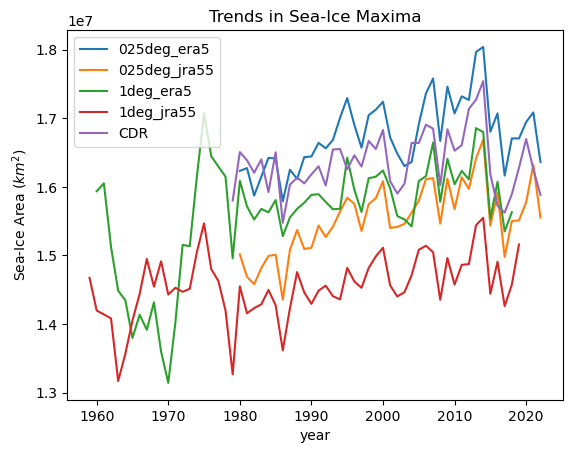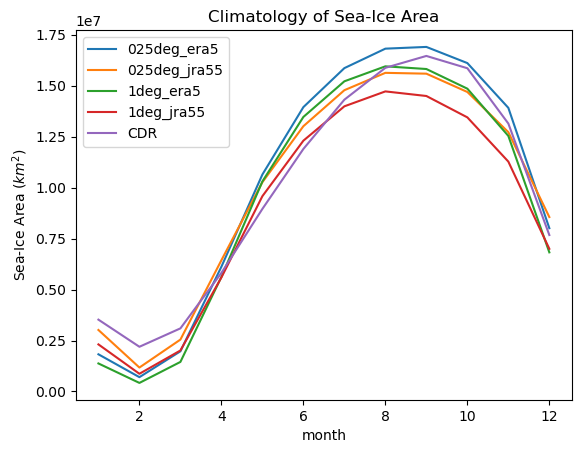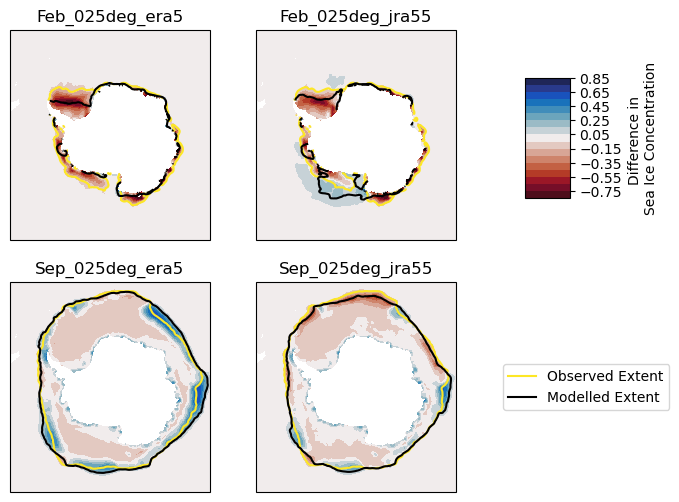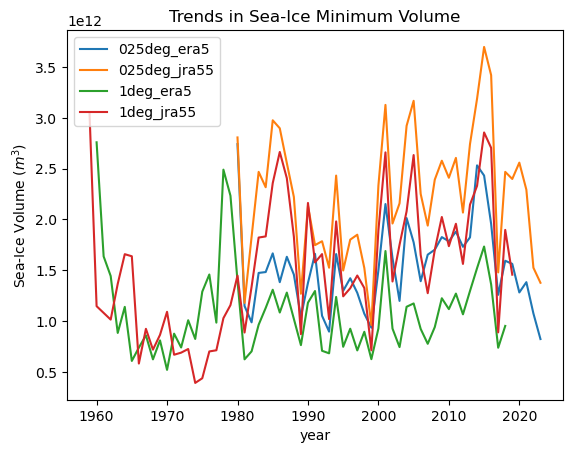Sea Ice Comparisons to Observations¶
This script shows how to load and plot sea ice concentration from CICE output and compare it to the NSIDC CDR (National Snow and Ice Data Centre, Climate Data Record) dataset
This notebook uses the ACCESS-NRI Intake Catalog following the examples in Tutorials/Using the Intake Catalog.
Requirements: The runs analysed here are only in access-nri-intake-catalog version 0.1.0 or newer. This is included in conda/analysis3-23.10 or newer modules from /g/data/hh5/public/modules.
OM2 Experiments:
These are the ACCESS-OM2 runs we are going to use, we can compare results from prototype runs forced with ERA5 against normal runs using JRA55do, as described on the ACCESS_HIVE. To compare against the observational datasets, we use IAF (Inter-Annual Forcing). N.B. The JRA55do runs used here a slightly different to the typical (e.g. 025deg_jra55_iaf_omip2_cycle6) in the model version used and the timeframes evaluated.
[1]:
RUNS = {
"025deg_era5": ["025deg_era5_iaf"], # (our name: run name(s))
"025deg_jra55": ["025deg_jra55_iaf_era5comparison"],
"1deg_era5": ["1deg_era5_iaf"],
"1deg_jra55": ["1deg_jra55_iaf_era5comparison"],
}
We are going to look at Sea Ice Concentration and Sea Ice Volume
[2]:
VARS = ["aice_m", "hi_m" ] # ice area fraction or sea ice concentration, ice thickness averaged by grid cell area
VARS_2D = ["area_t", "geolat_t", "geolon_t"]
Observational Data:
Sea Ice concentration is measured through passive microwave remote sensing. We are going to use the NSIDC CDR Dataset (described at nsidc.org)
[3]:
OBS_TIME_SLICE = slice("1979", "2022")
sh_obs_url = "https://polarwatch.noaa.gov/erddap/griddap/nsidcG02202v4shmday"
nh_obs_url = "https://polarwatch.noaa.gov/erddap/griddap/nsidcG02202v4nhmday"
Load depenencies:
[4]:
from intake import cat
from datatree import DataTree, map_over_subtree
from dask.distributed import Client
import xarray as xr
import numpy as np
from datetime import timedelta
import cf_xarray as cfxr
import xesmf
# plotting
import matplotlib.pyplot as plt
import cartopy.crs as ccrs
import cmocean.cm as cmo
import matplotlib.lines as mlines
A standard way to calculate climatologies. (We start in 1991 as earlier decades are influenced by model spin-up for 0.25deg runs which only start in 1980.)
[5]:
CLIMAT_TIME_SLICE = slice("1991", "2020")
def climatology(ds):
return ds.sel(time=CLIMAT_TIME_SLICE).groupby("time.month").mean("time")
Start a dask client
[6]:
client = Client(threads_per_worker=1)
[7]:
client
[7]:
Client
Client-82739af4-af4f-11ee-a8ab-00000087fe80
| Connection method: Cluster object | Cluster type: distributed.LocalCluster |
| Dashboard: /proxy/8787/status |
Cluster Info
LocalCluster
368ce898
| Dashboard: /proxy/8787/status | Workers: 12 |
| Total threads: 12 | Total memory: 46.00 GiB |
| Status: running | Using processes: True |
Scheduler Info
Scheduler
Scheduler-5e767eb4-9bb1-4909-9836-f71918916db3
| Comm: tcp://127.0.0.1:36437 | Workers: 12 |
| Dashboard: /proxy/8787/status | Total threads: 12 |
| Started: Just now | Total memory: 46.00 GiB |
Workers
Worker: 0
| Comm: tcp://127.0.0.1:34807 | Total threads: 1 |
| Dashboard: /proxy/45181/status | Memory: 3.83 GiB |
| Nanny: tcp://127.0.0.1:35097 | |
| Local directory: /jobfs/105828095.gadi-pbs/dask-scratch-space/worker-hss2qp4d | |
Worker: 1
| Comm: tcp://127.0.0.1:35411 | Total threads: 1 |
| Dashboard: /proxy/44133/status | Memory: 3.83 GiB |
| Nanny: tcp://127.0.0.1:35507 | |
| Local directory: /jobfs/105828095.gadi-pbs/dask-scratch-space/worker-jfi7ibr0 | |
Worker: 2
| Comm: tcp://127.0.0.1:45509 | Total threads: 1 |
| Dashboard: /proxy/44183/status | Memory: 3.83 GiB |
| Nanny: tcp://127.0.0.1:32881 | |
| Local directory: /jobfs/105828095.gadi-pbs/dask-scratch-space/worker-wteqer_y | |
Worker: 3
| Comm: tcp://127.0.0.1:45305 | Total threads: 1 |
| Dashboard: /proxy/43281/status | Memory: 3.83 GiB |
| Nanny: tcp://127.0.0.1:42787 | |
| Local directory: /jobfs/105828095.gadi-pbs/dask-scratch-space/worker-qmj97pzg | |
Worker: 4
| Comm: tcp://127.0.0.1:32899 | Total threads: 1 |
| Dashboard: /proxy/35169/status | Memory: 3.83 GiB |
| Nanny: tcp://127.0.0.1:37179 | |
| Local directory: /jobfs/105828095.gadi-pbs/dask-scratch-space/worker-9_dlevac | |
Worker: 5
| Comm: tcp://127.0.0.1:46269 | Total threads: 1 |
| Dashboard: /proxy/43181/status | Memory: 3.83 GiB |
| Nanny: tcp://127.0.0.1:46061 | |
| Local directory: /jobfs/105828095.gadi-pbs/dask-scratch-space/worker-pz5meqx9 | |
Worker: 6
| Comm: tcp://127.0.0.1:37447 | Total threads: 1 |
| Dashboard: /proxy/39947/status | Memory: 3.83 GiB |
| Nanny: tcp://127.0.0.1:44547 | |
| Local directory: /jobfs/105828095.gadi-pbs/dask-scratch-space/worker-9xxdg58l | |
Worker: 7
| Comm: tcp://127.0.0.1:40031 | Total threads: 1 |
| Dashboard: /proxy/35517/status | Memory: 3.83 GiB |
| Nanny: tcp://127.0.0.1:43751 | |
| Local directory: /jobfs/105828095.gadi-pbs/dask-scratch-space/worker-1zozkmca | |
Worker: 8
| Comm: tcp://127.0.0.1:45655 | Total threads: 1 |
| Dashboard: /proxy/36103/status | Memory: 3.83 GiB |
| Nanny: tcp://127.0.0.1:40749 | |
| Local directory: /jobfs/105828095.gadi-pbs/dask-scratch-space/worker-9jire7j6 | |
Worker: 9
| Comm: tcp://127.0.0.1:35597 | Total threads: 1 |
| Dashboard: /proxy/33815/status | Memory: 3.83 GiB |
| Nanny: tcp://127.0.0.1:41195 | |
| Local directory: /jobfs/105828095.gadi-pbs/dask-scratch-space/worker-u_kzqqfh | |
Worker: 10
| Comm: tcp://127.0.0.1:43801 | Total threads: 1 |
| Dashboard: /proxy/41293/status | Memory: 3.83 GiB |
| Nanny: tcp://127.0.0.1:45225 | |
| Local directory: /jobfs/105828095.gadi-pbs/dask-scratch-space/worker-qa5n7tm3 | |
Worker: 11
| Comm: tcp://127.0.0.1:45909 | Total threads: 1 |
| Dashboard: /proxy/34123/status | Memory: 3.83 GiB |
| Nanny: tcp://127.0.0.1:43379 | |
| Local directory: /jobfs/105828095.gadi-pbs/dask-scratch-space/worker-nxj030bj | |
Open the ACCESS-NRI Intake Catalog
[8]:
catalog = cat.access_nri
Load the ACCESS-OM2 results¶
For CICE data in OM2, we need to do some wrangling to make it easier to deal with. This is described in more detail in DocumentedExamples/SeaIce_Plot_Example. Its included in this function:
[9]:
def open_by_name(name, vars):
"""Return a dataset for the requested name and vars"""
return (
catalog[name]
.search(variable=vars)
.to_dask(
xarray_open_kwargs={
"chunks": {"time": "auto", "ni": -1, "nj": -1},
"decode_coords": False,
},
xarray_combine_by_coords_kwargs={
"compat": "override",
"data_vars": "minimal",
"coords": "minimal",
},
)
)
[10]:
def open_by_experiment(exp_name, vars):
"""Concatenate any datasets provided for this experiment into one ds, and add area and geo coordinates"""
# get the data for each run of this config
cice_ds = xr.concat(
[open_by_name(iName, vars) for iName in RUNS[exp_name]], dim="time"
)
# We also want the area/lat/lon fields, but these are not time dependent.
area_ds = xr.merge(
[
xr.open_dataset(
catalog[RUNS[exp_name][0]]
.search(variable=iVar)
.df.path[0]
# path of the first file with the area field, the geolon field and the geolat field
).drop_vars("time")
for iVar in VARS_2D
]
)
# Label the lats and lons
cice_ds.coords["ni"] = area_ds["xt_ocean"].values
cice_ds.coords["nj"] = area_ds["yt_ocean"].values
# Copy attributes for cf compliance
cice_ds.ni.attrs = area_ds.xt_ocean.attrs
cice_ds.nj.attrs = area_ds.yt_ocean.attrs
cice_ds = cice_ds.rename(({"ni": "xt_ocean", "nj": "yt_ocean"}))
# Add the geolon, geolat, and area as extra co-ordinates fields from area_t
cice_ds = cice_ds.assign_coords(
{
"geolat_t": area_ds.geolat_t,
"geolon_t": area_ds.geolon_t,
"area_t": area_ds.area_t,
}
)
# cice timestamps are also misleading:
cice_ds["time"] = cice_ds.time.to_pandas() - timedelta(minutes=1)
return cice_ds
Because the dimensions are different for different experiments, they would not fit in a Dataset, a DataTree is required. The DataTree has a group for each experiment, which contains a xarray dataset with the data for that experiment.
[11]:
%%time
si_name_ds_pairs = [(iRun, open_by_experiment(iRun, VARS)) for iRun in RUNS.keys()]
si_dt = DataTree.from_dict(dict(si_name_ds_pairs))
0.3.0
CPU times: user 35.8 s, sys: 3.29 s, total: 39 s
Wall time: 1min 27s
[12]:
@map_over_subtree
def match_timestamps_to_CDR(ds):
cice_ds = ds.copy()
# we are going to use the same timestamps as NSIDC
cice_ds["time"] = [
np.datetime64(str(i)[0:7] + "-01T00:00:00.000000000")
for i in cice_ds.time.values
]
return cice_ds
[13]:
si_dt = match_timestamps_to_CDR(si_dt)
The result is a datatree, with a dataset for each experiment and timestamps which align with the observational timestamps
[14]:
si_dt
[14]:
<xarray.DatasetView>
Dimensions: ()
Data variables:
*empty*Load the observational dataset¶
The CDR dataset has the area of each grid cell provided as a seperate file, which we need to load
[15]:
def open_cdr_dataset(path, area_file):
ds = xr.open_dataset(path).rename(
{'cdr_seaice_conc_monthly': 'cdr_conc', 'xgrid':'x','ygrid':'y'}
)
# # we also need the area of each gridcell
areasNd = np.fromfile(area_file, dtype=np.int32).reshape(
ds.cdr_conc.isel(time=0).shape
)
# # Divide by 1000 to get km2 (https://web.archive.org/web/20170817210544/http://nsidc.org/data/polar-stereo/tools_geo_pixel.html#pixel_area)
areasKmNd_sh = areasNd / 1000
ds["area"] = xr.DataArray(areasKmNd_sh, dims=["y", "x"])
ds = ds.set_coords("area")
ds = ds.cdr_conc
ds = ds.where(ds<=1) # convert error codes to Nan
return ds
We can pull the datasets direct from the url, however the cell area needs to be downloaded seperately:
[16]:
!wget --ftp-user=anonymous -nc ftp://sidads.colorado.edu/DATASETS/seaice/polar-stereo/tools/pss25area_v3.dat ftp://sidads.colorado.edu/DATASETS/seaice/polar-stereo/tools/psn25area_v3.dat
File ‘pss25area_v3.dat’ already there; not retrieving.
File ‘psn25area_v3.dat’ already there; not retrieving.
We are interested in the Antarctic, but the lines for the Arctic are below and commented out.
[17]:
sh_cdr_xr = open_cdr_dataset(sh_obs_url, "pss25area_v3.dat")
# nh_cdr_xr = open_cdr_dataset(
# nh_obs_url,
# 'psn25area_v3.dat'
# )
cdr_dt = DataTree.from_dict(
{
"cdr_sh": sh_cdr_xr,
# 'cdr_nh':nh_cdr_xr
}
)
The result is a datatree, with a datasets for the relevant hemisphere
Calculate Sea Ice Area¶
Sea ice area is the circumpolar sum of sea ice concentration multiplied by the area of each grid cell. By convention, and because lower concentrations are not accurate when measured through remote sensing, concentrations below 0.15 are not included
[18]:
def sea_ice_area(sic, area, range=[0.15, 1]):
return (sic * area).where((sic >= range[0]) * (sic <= range[1])).cf.sum(["X", "Y"])
Calculate for observational data, and remove gaps with missing data
[19]:
@map_over_subtree
def sea_ice_area_obs(ds):
sic = ds.cdr_conc
result = sea_ice_area(sic, sic.area).to_dataset(name="cdr_area")
# Theres a couple of data gaps which should be nan
result.loc[{"time": "1988-01-01"}] = np.nan
result.loc[{"time": "1987-12"}] = np.nan
return result.sel(time=OBS_TIME_SLICE)
[20]:
obs_area_dt = sea_ice_area_obs(cdr_dt)
[21]:
# Theres another gap which should be nan in the arctic only
# obs_area_dt['cdr_nh'].to_dataset().loc[{'time':'1984-07'}]=np.nan
Calculate for model data, limit to southern hemisphere / Antarctica
[22]:
@map_over_subtree
def sea_ice_area_model_sh(ds):
sic = ds.aice_m.cf.sel(Y=slice(-90, 0))
area_km2 = ds.area_t / 1e6
return sea_ice_area(sic, area_km2).to_dataset(name="si_area").load()
[23]:
model_area_dt = sea_ice_area_model_sh(si_dt)
Sea Ice Area Trends¶
We are going to compare the trends in the minima and maxima over time, and the monthly climatology
[24]:
@map_over_subtree
def min_and_max(ds):
def min_and_max_year(da):
result = xr.Dataset()
result["min"] = da.min()
result["max"] = da.max()
return result
annual_min_max_ds = ds.si_area.groupby("time.year").apply(min_and_max_year)
return annual_min_max_ds
model_min_max_dt = min_and_max(model_area_dt)
[25]:
for iGroup in model_min_max_dt.groups[1:]:
ds = model_min_max_dt[iGroup].ds
ds["min"].plot(label=iGroup[1:])
obs_area_dt["cdr_sh"].ds.cdr_area.groupby("time.year").min().plot(label="CDR")
plt.title("Trends in Sea-Ice Minima")
plt.ylabel("Sea-Ice Area ($km^2$)")
_ = plt.legend()

We see that all models have sea ice area which is too low in summer. Model runs forced by JRA have more variability than those forced by ERA5 and are slightly closer to the measured sea ice area from observations.
[26]:
for iGroup in model_min_max_dt.groups[1:]:
ds = model_min_max_dt[iGroup].ds.sel(
year=slice(1950, 2022)
) # drop 2023 because its incomplete
ds["max"].plot(label=iGroup[1:])
obs_area_dt["cdr_sh"].ds.cdr_area.groupby("time.year").max().plot(label="CDR")
plt.title("Trends in Sea-Ice Maxima")
plt.ylabel("Sea-Ice Area ($km^2$)")
_ = plt.legend()

We see that the closest runs are those forced by ERA5, and the runs forced by JRA55 are under representing Winter sea ice.
[27]:
for iGroup in model_area_dt.groups[1:]:
climatology(model_area_dt[iGroup].ds.si_area).plot(label=iGroup[1:])
climatology(obs_area_dt["cdr_sh"].ds.cdr_area).plot(label="CDR")
plt.title("Climatology of Sea-Ice Area")
plt.ylabel("Sea-Ice Area ($km^2$)")
plt.legend()
[27]:
<matplotlib.legend.Legend at 0x14e242887850>

We see all model runs have too low sea ice in summer, and grow faster than observations in autumn and earlier that the observed maximum.
Sea Ice Concentration Anomalies¶
To examine the differences between the model results and observations, we calculate difference in each grid cell between observations and each experiment
As that data are on different grids, we need to regrid to compare the datasets
Lets simplify a little to only look at 0.25 degree results
[28]:
groups = ("/025deg_era5", "/025deg_jra55")
The lat/lon of of each cell in the observational dataset are in a different file:
[29]:
! wget -nc https://noaadata.apps.nsidc.org/NOAA/G02202_V4/ancillary/G02202-cdr-ancillary-sh.nc
File ‘G02202-cdr-ancillary-sh.nc’ already there; not retrieving.
[30]:
cdr_sps_ds = xr.open_dataset("G02202-cdr-ancillary-sh.nc")
We can now build the re-gridder. This is described in detail in DocumentedExamples/Regridding
[31]:
regridder_ACCESSOM2_025deg_sh = xesmf.Regridder(
si_dt["025deg_era5"].ds.isel(time=0).drop_vars(["xt_ocean", "yt_ocean"]),
cdr_sps_ds,
"bilinear",
periodic=True,
unmapped_to_nan=True,
)
[32]:
aice_sh_3976_ds = xr.Dataset()
aice_sh_anom_ds = xr.Dataset()
for iG in groups:
aice_sh_3976_ds[iG] = regridder_ACCESSOM2_025deg_sh(
si_dt[iG].ds.aice_m.copy()
)
aice_sh_anom_ds[iG] = aice_sh_3976_ds[iG] - cdr_dt["cdr_sh"].ds.cdr_conc
We can now plot the difference between modelled and observed sea ice concentration
[33]:
months = [2, 9] # february, september
month_names = ["Feb", "Sep"]
n_months = len(months)
plt.figure(figsize=(9, n_months * 3))
cdr = climatology(cdr_dt["cdr_sh"].ds.cdr_conc)
for j, iGroup in enumerate(aice_sh_anom_ds.data_vars):
anoms = climatology(aice_sh_anom_ds[iGroup])
aice = climatology(aice_sh_3976_ds[iGroup])
for i, iMonth in enumerate(months):
plt.subplot(
n_months,
3,
j + 1 + i * 3,
projection=ccrs.SouthPolarStereo(true_scale_latitude=-70),
)
# Filled contours with concentration anomalies in this month
ds = anoms.sel(month=iMonth).compute()
plt.contourf(
ds.x, ds.y, ds, levels=np.arange(-0.85, 0.86, 0.1), cmap=cmo.balance_r
)
# Lines at 15% concentration (approx ice edge)
cs_cdr = cdr.sel(month=iMonth).plot.contour(levels=[0.15])
cs_mod = aice.sel(month=iMonth).plot.contour(levels=[0.15], colors=["black"])
plt.title(month_names[i] + "_" + iGroup[1:])
# Messy legend creation
color_cdr = cs_cdr.collections[0].get_edgecolor()
line_cdr = mlines.Line2D([], [], color=color_cdr, label="Observed Extent")
color_mod = cs_mod.collections[0].get_edgecolor()
line_mod = mlines.Line2D([], [], color=color_mod, label="Modelled Extent")
plt.legend(handles=[line_cdr, line_mod], loc="center left", bbox_to_anchor=(1.2, 0.5))
# And colorbar
cax = plt.axes([0.7, 0.6, 0.05, 0.2])
_ = plt.colorbar(cax=cax, label="Difference in \nSea Ice Concentration")
/g/data/hh5/public/apps/miniconda3/envs/analysis3-23.10/lib/python3.10/site-packages/distributed/client.py:3162: UserWarning: Sending large graph of size 217.46 MiB.
This may cause some slowdown.
Consider scattering data ahead of time and using futures.
warnings.warn(
/g/data/hh5/public/apps/miniconda3/envs/analysis3-23.10/lib/python3.10/site-packages/distributed/client.py:3162: UserWarning: Sending large graph of size 217.46 MiB.
This may cause some slowdown.
Consider scattering data ahead of time and using futures.
warnings.warn(
/g/data/hh5/public/apps/miniconda3/envs/analysis3-23.10/lib/python3.10/site-packages/distributed/client.py:3162: UserWarning: Sending large graph of size 217.46 MiB.
This may cause some slowdown.
Consider scattering data ahead of time and using futures.
warnings.warn(
/g/data/hh5/public/apps/miniconda3/envs/analysis3-23.10/lib/python3.10/site-packages/distributed/client.py:3162: UserWarning: Sending large graph of size 217.46 MiB.
This may cause some slowdown.
Consider scattering data ahead of time and using futures.
warnings.warn(

We see that OM2 under-represents sea ice in Summer, particularly in the Weddell Sea. In Winter, trends are less clear, although ERA5 forced sea ice concentration is too high at the northern boundary.
Sea Ice Volume¶
We can calculate volume in much the same way as area, except vicen is volume (per unit area) in each of 5 thickness classes, so we can sum this for the volume irrespective of thickness.
[34]:
@map_over_subtree
def sea_ice_vol_model_sh(ds):
vice_m = ds.hi_m.sel(yt_ocean=slice(-90, 0))
siv_total_da = (
(vice_m * ds.area_t)
.where(~np.isnan(ds.area_t))
.cf.sum(["longitude", "latitude"])
)
return siv_total_da.to_dataset(name="si_vol").load()
[35]:
si_vol_dt = sea_ice_vol_model_sh(si_dt)
[36]:
@map_over_subtree
def min_and_max(ds):
def min_and_max_year(da):
result = xr.Dataset()
result["min"] = da.min()
result["max"] = da.max()
return result
annual_min_max_ds = ds.si_vol.groupby("time.year").apply(min_and_max_year)
return annual_min_max_ds
model_min_max_dt = min_and_max(si_vol_dt)
[37]:
for iGroup in model_min_max_dt.groups[1:]:
ds = model_min_max_dt[iGroup].ds
ds["min"].plot(label=iGroup[1:])
plt.title("Trends in Sea-Ice Minimum Volume")
plt.ylabel("Sea-Ice Volume ($m^3$)")
_ = plt.legend()

[38]:
for iGroup in model_min_max_dt.groups[1:]:
ds = model_min_max_dt[iGroup].ds.sel(
year=slice(1950, 2022)
) # drop the last year because its incomplete
ds["max"].plot(label=iGroup[1:])
plt.title("Trends in Sea-Ice Maximum Volume")
plt.ylabel("Sea-Ice Volume ($m^3$)")
_ = plt.legend()

[39]:
for iGroup in si_vol_dt.groups[1:]:
climatology(si_vol_dt[iGroup].ds.si_vol).plot(label=iGroup[1:])
plt.title("Climatology of Sea-Ice Volume")
plt.ylabel("Sea-Ice Volume ($m^3$)")
_ = plt.legend()

[40]:
client.close()
0.3.0
0.3.0
0.3.0
0.3.0
0.3.0
0.3.0
0.3.0
0.3.0
0.3.0
0.3.0
0.3.0
0.3.0
[ ]: